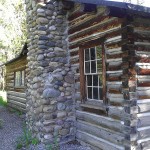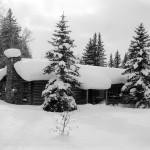Maud arrived in Jackson Hole in 1915 from a wealthy family in Philadelphia. She came out to stay with Mrs. George Woodward at the Bar BC Ranch. It is estimated that she was between 45 and 50 years old. She meant to stay only for the summer but decided to make the valley her permanent home. The next summer, she contracted Harry Clissold to build her a three-room cabin on Cottonwood Creek, near the Beaver Creek housing area. In 1918, Menor’s Ferry and property were up for sale, and Maud decided to purchase it and move her cabin to her new parcel. When the cabin was moved, the kitchen area was removed to create a second bedroom. Maud took her meals in Bill Menor’s old cabin, thus removing the need for a kitchen in her own home. The second bedroom was occupied by Sydney Frederick Sandell, who split the purchase of the ferry property with Maud.
Maud and Sandell jointly ran the ferry, charging $1 for Wyoming cars and $2 for anyone out of state. Little is known today about their relationship. They were not married, and it is believed that Sandell even had a wife back home. They did have separate bedrooms in Maud’s cabin. It was seen as impolite during this time to talk about unmarried men and women living together, so many accounts leave Sandell out of the picture, or only briefly mention him in passing. It would appear as though Maud favored this arrangement, and did little to leave her own notes on the situation. We do know that they sold the ferry together, and moved to a second ranch near Wilson. Their housing arrangements there are also unknown. They parted ways in 1943 when Maud returned home to Philadelphia where she lived until her death.
On July 23, 1923, a meeting of Horace Albright, Joe Joffe (Albright’s secretary), Richard Winger, J.R. Jones, J.L. Eynon, Struthers Burt and Horace Carncross. This very famous meeting took place in Noble’s living room; however there is no record that shows if she was present. While she does not appear to have participated in the meeting, she may well have overheard the discussion. This meeting was the first of its kind between parties interested in preserving Jackson Hole from development. No mention was made of the inclusion of a National Park, or an extension of Yellowstone. Albright was present merely to hear the ideas and concerns of the few valley residents who were interested in keeping commercial development out of Jackson Hole. They decided the only way to do this was to contact their wealthy friends and connections back east in order to purchase the necessary lands for preservation. There was little to no mention of a governing power, however, Albright privately knew that the National Park Service was the only option. Albright raised $2,000.00 for a few of the meeting members to travel back East for that fall to try to collect interested parties for the next summer. Those in attendance figured it was a matter of months, but Albright has been quoted as knowing it would take “5 years or more.”
Much stock is put on this meeting as the first mention of Jackson Hole being put into federally preserved and regulated lands. Nothing of the sort was mentioned, or even considered by the local residents. They merely wanted to prevent outsiders from buying up the remaining free lands or those from poorer homesteaders looking to leave, to prevent developments upon these tracts.
In 1927 the Bureau of Public Roads built a bridge over the Snake River, just south of the ferry line. On the west side, the bridge connected the small cluster of buildings around the ferry which included the Moose post office, school, and small general store. On the east, the small beginning of Dornan’s was just beginning with the construction of several cabins for overnight visitors. The bridge provided a safer river crossing for free, so use of the ferry all but stopped. Maud and Sandell sold their property to the Snake River Land Company in 1929, and moved to a ranch south of Wilson. Over the next two decades, several individuals and families occupied Maud’s old cabin. The building underwent several changes to serve different uses. A kitchen was retrofitted into Maud’s old bedroom, both porches were enclosed, and a small addition was added to create another bedroom.
The biggest changes to the building were under Josephine and Harold Fabian, who were given management of the property in 1949. Harold Fabian worked for John D. Rockefeller, Jr. as a lawyer, and lived in Jackson Hole to oversee the Snake River Land Company as Vice President (later the Jackson Hole Preserve, Inc.). The Fabians undertook a full restoration of the property, returning it to its historic use as a ferry and general store. Fortunately, their efforts lead to the preservation of the entire district and prevented the buildings from falling into disrepair and being removed. After 1950 Maud’s cabin was used as National Park Service housing and later was converted into a small interpretive center. It still serves this purpose today, and the Menor’s Ferry Historic District is one of the most-visited historic sites in Grand Teton National Park.
TIMELINE
1915: Maud Noble arrives in Jackson Hole as a guest at the Bar BC Ranch and friend of Mrs. George Woodward. After staying at the Bar BC for the summer, she makes arrangements to stay permanently in the valley.
1916: Harry Clissold builds Maud a 3-room cabin on the east side of Cottonwood Creek. She lives here for about a year.
1918: Maud purchases the Menor’s Ferry property along with a man named Sydney Frederick Sandell.
1923: July 23 meeting of Horace Albright, Joe Joffe (Albright’s secretary), Richard Winger, J.R. Jones. J.L Eynon, Struthers Burt and Horace Carncross in Maud’s living room. They meet to discuss the future of the valley and how to keep it from becoming too developed.
1927-1928: Bureau of Public Roads constructs a bridge just south of the ferry line in Moose. Noble & Sandell abandon the ferry operation and move to a ranch south of Wilson.
1929: Maud sells her Moose property to the Snake River Land Company.
1930-1937: Reed Turner and Jack Woodmen briefly live in the cabin, but neither makes a distinct mark on the property or buildings.
1937: Jim & Viola Budge move into the cabin. They make several changes to the interior: a
kitchen (in Maud’s bedroom) and enclosed both the south and east porches.
-The eastern porch is enclosed to create a space for their sons’ bedroom.
-The Budges also own and run the Moose Post Office & Store.
1943: Bob & Fran Carmichael purchase the Moose P.O. & Store from the Budges and move in.
1948: Mrs. Rush lives here for a short time.
1949: The property is still under the possession of John D. Rockefeller, Jr. and he hands management over to Harold and Josephine Fabian (Rockefeller’s lawyer who managed his operations in Jackson Hole). The Fabians oversee the reconstruction of the Menor’s Ferry area, and restore the Maud Noble cabin back to its original (exterior) appearance. Josephine operates a tea room in the cabin for two years. The tea room also offers light dining options.
1951-Present: The cabin houses a series of seasonal park employees before conversion to an interpretive structure.
Text by Samantha Ford, Director of Historical Research and Outreach


